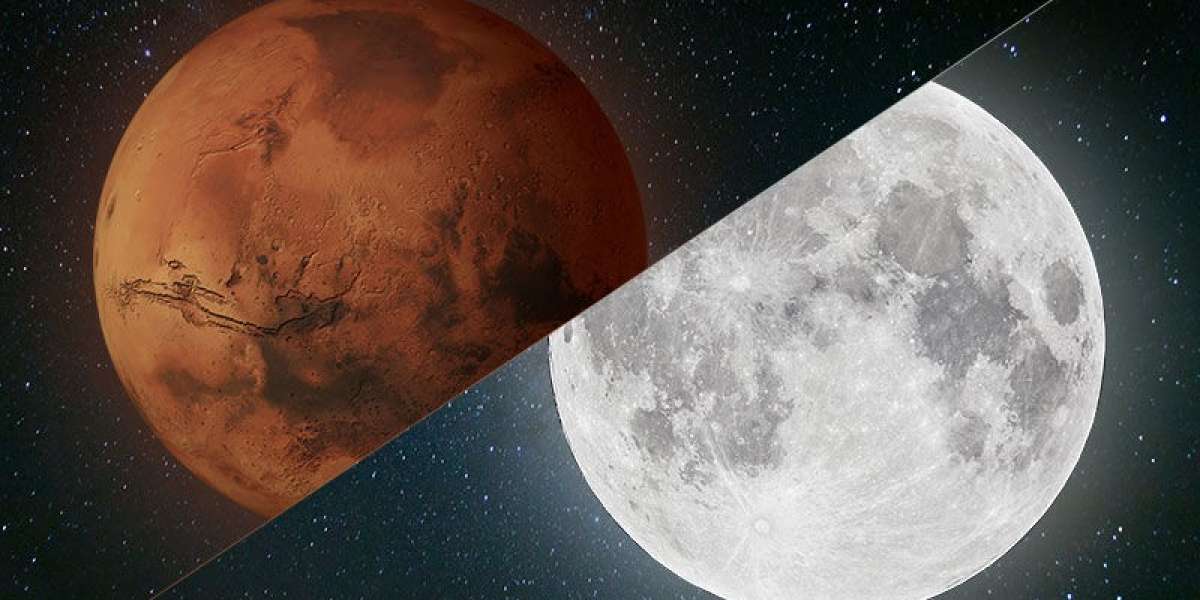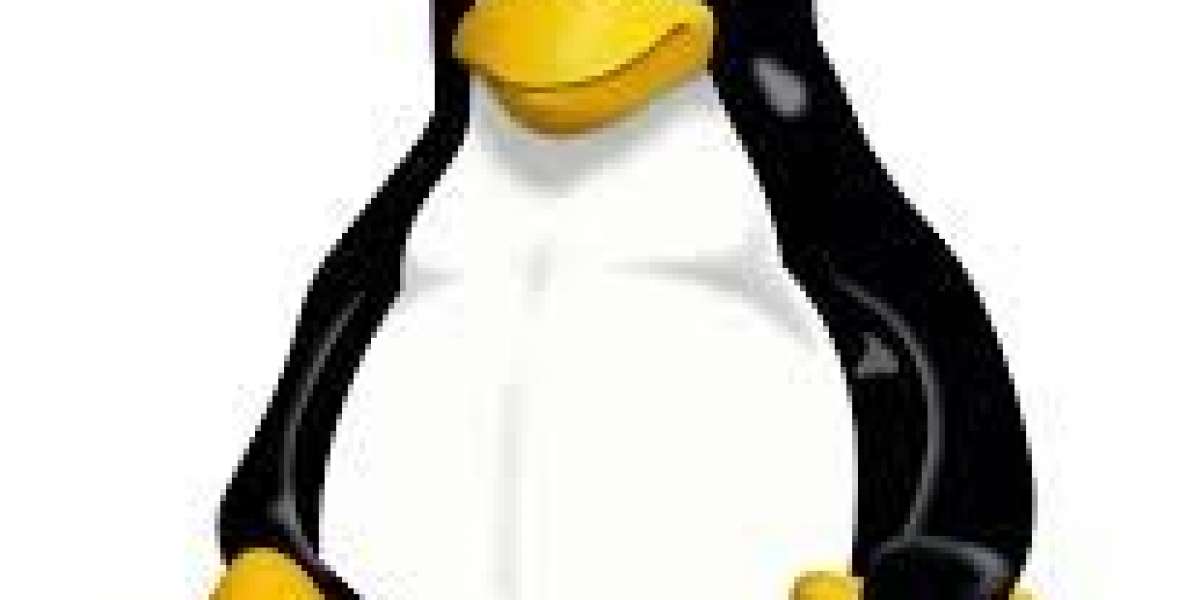Missions to other planetary bodies are the future of space travel. In the near future we are going to go to the Moon and Mars. The nature of these missions will be evolutionary starting from small architectures with minimal elements and evolving into bulkier concepts. In the design of these concepts the capability of the transportation elements is not always harnessed to full potential. In most designs the transportation element is utilized only to perform one function whereas, it could be designed from the beginning so that it can accommodate more functions. If we commonalise functions it leads to multiple advantages such as:
- Interchangeable – In case of an emergency a module destined for one destination may be easily replaced due to the availability of multiple spare modules already produced leading to financial benefits
- Reduced Cost – Since a single habitat can be used for both Lunar and Martian missions, the development cost reduces by 50% since only one module development phase is required.
- Empirical Contingency Procedures – In case of an on-surface emergency or malfunction the crew does not need to be trained on different elements. Their training on a single module can be universal irrespective of whether they are assigned to a lunar crew or Mars crew.
- Simpler Manufacturing – Space habitats require a long time and high precision to be manufactured due to their critical nature. Ensuring manufacturing of only one type of product increases experience as well as reduces cost.
- Less Spares – If two different habitats are to be made, they would require a different set of spares leading to manufacturing and inventory management. If a common habitat is developed such efforts are reduced.
- Easier Troubleshooting – A single habitat can be widely tested to find all failure modes. If all failure modes are known, dedicated staff and training required for troubleshooting is reduced.
- Common Training – As indicated above, crew and support staff don’t have to be accustomed to multiple elements and can utilize their common training to develop other solutions that might work in both environments.
A Case for Commonality
Commonality has certain benefits when it is designed into systems. As per a study conducted in 2015 commonality plays a huge part in decreasing costs and simplifying mission architecture. In this study 1.Griffin et. Al. looked at different elements that were designed as part of a Mars architecture. Each element had a separate role. But some functions of the elements were similar such as mission requirements in terms of duration of use, crew capacity and reusability. The elements for this mission were a combination of crew and cargo vehicles. The study developed a habitation element which could function as a habitat as well as a cargo element. They integrated the new designed habitat with some parts of the old design. The new elements performed the desired functions by using the common habitat element. As a result, it was concluded that trying to incorporate commonality into a new design is easier as compared to designing elements and trying to find common functions or uses. Commonality also provides the unique advantage of cost savings. In this case the cost saving was approximately $1.5 billion which is about 8% of the current NASA budget. If these funds were available, they could be diverted to other studies which in turn could lead to technology development for other missions.
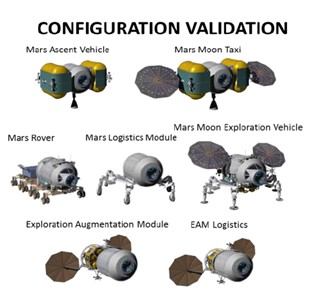
Figure -1 – Architecture elements developed as part of Mars architecture
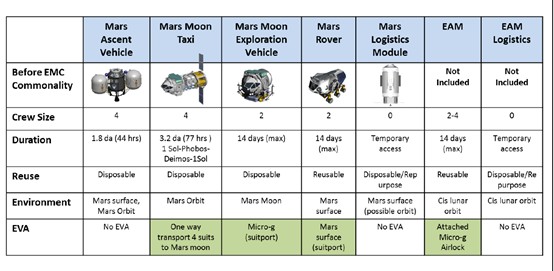
Figure -2 – Modified Architecture elements utilizing common habitat
Hence, this study tries to introduce commonality as part of the design process from the beginning. When on Moon/Mars several elements are going to be used if all the functions needed are listed in the design phase then it can be explored that how these functions can be performed by similar elements. For example, in this case some elements that would be common were the habitat, transportation elements, power elements and rovers. Some of these elements are already in mid TRL levels such as the chariot rover.
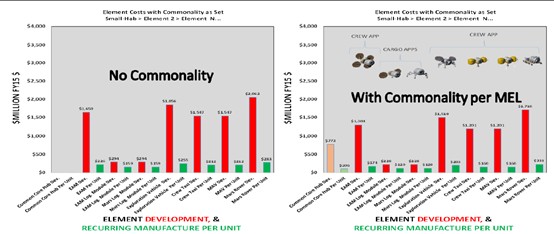
Figure -3 – Cost Comparison of architecture with and without commonality
Design Criteria for a Common Habitat
In order to achieve a common design, the process starts with defining a set of high-level guidelines to assist in the design process. These guidelines are stated below.
Vision
To reduce the cost of space missions to build widespread colonies on the Moon and Mars.
Mission
Develop a set of elements that can be used on the Moon and Mars based on their varied environmental and mission parameters.
Goals
- Should define form and configuration of given habitats.
- Should define functional distribution of base.
- Should design subsystems that can be used in both environments.
Objectives
- Identify different habitat forms and compare them.
- Identify different habitat configurations.
- Identify variety of functions required on the base.
- Find subsystems required for providing given functions and modify them to function in both environments.
- Integrate modified subsystems with designed habitat.
- Assess feasibility of designed habitat to be adapted to zero gravity.
Requirements
- Shall be capable of supporting four crew for mission duration.
- Shall be capable of resisting high temperature variations.
- Shall have internal systems capable of self-adjusting to different gravity environments.
- Structure should be able to support launch and landing loads.
- Shall be able to shield humans from high radiation environment.
Assumptions
- Shorter duration sortie missions have been conducted.
- All technologies used are matured by mission launch.
- Mars and Moon present same radiation environment.
- Suitable quality control standards exist for all elements.
Risks
- Different partial gravity environments present a big difference.
- Lunar systems are overdesigned resulting in higher cost.
Conclusion
The journey for a common design process is long and tedious. Even though the financial benefits can be up to 50% a rigid development structure restricts commonality. This article provided in-depth analysis of why commonality should be encouraged from the beginning of the design phase. It also went to greater depth to state how the high-level development criteria for a habitat system may look like and the risks involved. It is understood that the risks are a result of insufficient data and as unmanned missions make way to these destinations the risks will reduce.
With the dawn of a new space age it is essential that we move forward with an open mindset and give a chance to commonality to lead us into the future of space travel!
Chime in with your opinion in the comments below.
